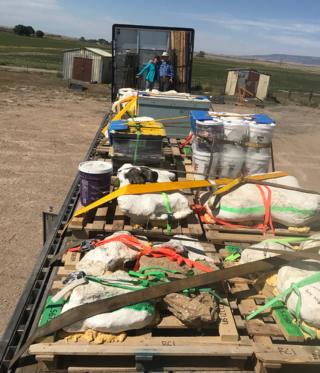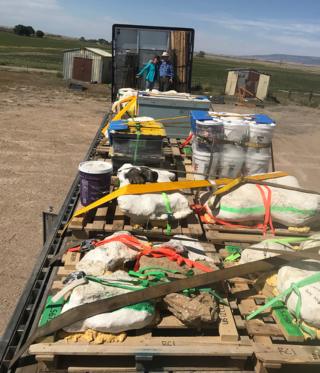‘Mission Jurassic’ fossil dinosaur dig closes for winter

 Image copyright Phil Manning
Image copyright Phil Manning 
Three full truck loads of dinosaur fossils were shipped out of the “Mission Jurassic” dig site in North Wyoming as scientists brought the 80-day excavation season to an end.
The specimens included skeletal parts from giant herbivorous sauropods and meat-eating theropods.
The fossils will now be cleaned to see precisely which species they represent.
Mission Jurassic is a major undertaking involving researchers from the US, the UK and the Netherlands.
It is led by The Children’s Museum of Indianapolis (TCMI) which has taken out a 20-year lease on a square mile (260 hectares) of ranch land.
The BBC was given special access to the site in July.
The fossil beds exposed at the secret location in the Big Horn Basin record dinosaur activity around 150 million years ago – and the summer’s work confirms the site is particularly rich.
One three-tonne block of rock lifted on the final day last week was embedded with multiple remains all stacked one on top of the other.
“Overall we must have moved something like 500-600 bones; it’s just a huge amount of material we’ve been able to shift in one year,” said Prof Phil Manning, a University of Manchester palaeontologist and TCMI scientist in residence.
The Children’s Museum has been working the site with teams from Manchester, London’s Natural History Museum and Leiden’s Naturalis Biodiversity Centre.
They’ve been scraping back the layers in two pilot quarries. One of these appears to be a watering hole where various different animals congregated. Not only are their bones preserved in the sediments but so too are the footprints they made as they sploshed through muddy ground.
“We have astounding trackways now – over a hundred individual tracks from different creatures. It’s pretty cool because we see evidence of the animals when they were dead and when they were alive,” Prof Manning told BBC News.
He wants to double the size of the dig teams next season, opening up Mission Jurassic again in mid-April to run through perhaps into September.
This will require some negotiations with the international partners but the Manchester man believes the institutions’ continued commitment will be rewarded.
“I truly believe this will become the largest ever dinosaur dig for any group of British scientists – led of course by The Children’s Museum.”
Some of the remains trucked out last week will go to Indianapolis and some to a Canadian company called Research Casting International.
The fossils were encased in plaster jackets to protect them during their journey to the lab. Special tools and techniques will be used to clean the bones of extraneous rock. Once that’s done, scientists can begin to examine them in detail.
The excavation site has outcrops of two key rock formations from the end stages of the Jurassic. One is the Morrison, which was laid down when what is now North Wyoming was a forested landscape, and the other is the Sundance, which was a preceding environment dominated by a shallow sea.
Scientists should therefore have access to a wide range of both land and marine creatures inside the one square mile.
Before Prof Manning’s teams left the dig site, they set up security cameras. The local police and the Bureau of Land Management will be keeping an eye on the quarries through the winter to ensure fossil thieves don’t try to lift fossils in the scientists’ absence.
Jonathan.Amos-INTERNET@bbc.co.uk and follow me on Twitter: @BBCAmos


